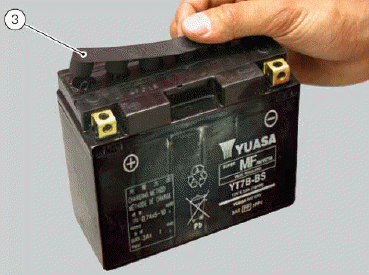 Ducati Scrambler 800 - Service manual > Topping up the electrolyte
Ducati Scrambler 800 - Service manual > Topping up the electrolyte
Remove the battery (Battery).
Warning Before carrying out any operations on the battery, keep in mind the safety standards (General safety rules).
The electrolyte in the battery is toxic and can cause burns if it comes into contact with the skin because it contains sulphuric acid. Wear protective clothing, a face-mask and goggles when adding electrolyte. If the fluid comes into contact with the skin, wash thoroughly with fresh water. If it comes into contact with the eyes, wash thoroughly with water for 15 minutes and consult an ophthalmologist. In the event of accidental ingestion, drink large quantities of water or milk, and continue with milk of magnesia, a beaten egg or vegetable oil. Do not allow sparks, flames or any other heat source to get near the battery, as it produces explosive gases. When recharging or using the battery indoors, make sure that the room is adequately ventilated. Do not inhale the gases produced during recharging. KEEP OUT OF REACH OF CHILDREN.
Place the battery on a flat surface. Remove the protective film (1).

Warning Make sure that the electrolyte is of the specific type for your battery.
Remove the container with the electrolyte from the plastic bag.
Remove the cap strip (3) from the container (2).

Important Keep the cap strip (3) to hand because it will be used later to plug the battery cells.
Warning Do not peel or perforate the sealed areas.
Place the electrolyte container (2) upside down. Align the six sealed elements with the six filler holes on the battery. Push the container (2) downwards with sufficient force to break the seals and allow the fluid to flow out.

Note Do not tilt the electrolyte container as this could interrupt the flow temporarily or even permanently.
Make sure that air bubbles emerge from all six filler holes. Leave the container in this position for at least twenty minutes.
If no bubbles emerge from one of the holes, tap gently on the bottom of the respective container.

Important Never move the container away from the battery. Do not cut or puncture the container.
Make sure that all the electrolyte has flowed out. Carefully extract the container (2) from the battery.
Fit the cap strip (3) previously removed from the electrolyte container (2) to the battery, and ensure the caps plug off all filler holes.

3-12 Ah batteries: leave to stand for at least 30 min.
Over 12 Ah batteries: leave to stand for at least 1 hour.
Set the cap strip on the filler holes without securing it. Recharge the battery as described in the paragraph "Recharging the battery".
Note When using an automatic battery charger, ensure that the charger current (ampere) is equal to or higher than the value of the standard charging system (STD) indicated on the battery itself.
Press firmly downwards with both hands until the caps are firmly in place (do not use a hammer).

Recharging the battery
Refer to the label on the battery showing the inspection intervals in order to determine when to test the voltage.

Charge the battery if the open circuit voltage is lower than 12.8 V. Leaving the battery discharged for more than one month could damage it. Check the battery charge with a voltmeter.
Always check the condition of the battery before recharging and 1 to 2 hours afterwards.
Warning Pay careful attention to recharging times. Stop charging immediately if the battery becomes too hot to the touch. Leave to cool before resuming charging.
Use only constant-voltage battery chargers.
Check that battery terminals are properly connected to the battery charger.
To charge the battery, proceed as follows.

Use fast charging in emergencies only.
Storing the battery
If the battery voltage is less than or equal to 11.5V, it must be recharged.
Connect the battery charger to the battery.
Use a voltage of 16-17V.
If the ammeter shows no change, increase the voltage to maximum 25V.
Charge for 5 minutes.
If the ammeter shows a change, restore a voltage of 16-17V; otherwise replace the battery.
Checking the battery charging system
Perform checks on the system as indicated in the following paragraphs:
- Recharging the battery
- Topping up the electrolyte
- Battery
- Alternator
- Rectifier-regulator
See also:
 Ducati Scrambler 800 - Service manual > Alternator / Generator
Ducati Scrambler 800 - Service manual > Alternator / Generator
The generator used on the Scrambler has a rated power of 490 W at 14 V and consists of a fixed element (stator/generator, A), located in the generator cover and a mobile element (rotor/flywheel, B) fastened to the crankshaft.
 Ducati Scrambler
Ducati Scrambler Fantic Caballero 500
Fantic Caballero 500 Indian FTR 1200
Indian FTR 1200 Moto Guzzi V85 TT
Moto Guzzi V85 TT Royal Enfield Bullet Trials Works Replica
Royal Enfield Bullet Trials Works Replica Triumph Scrambler 1200 XE
Triumph Scrambler 1200 XE Triumph Street Scrambler
Triumph Street Scrambler Yamaha XSR700
Yamaha XSR700 Ducati Scrambler 800
Ducati Scrambler 800 Moto Guzzi V85 TT
Moto Guzzi V85 TT Triumph Scrambler 1200 XC
Triumph Scrambler 1200 XC